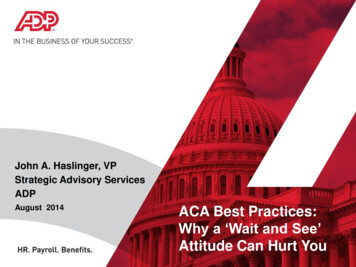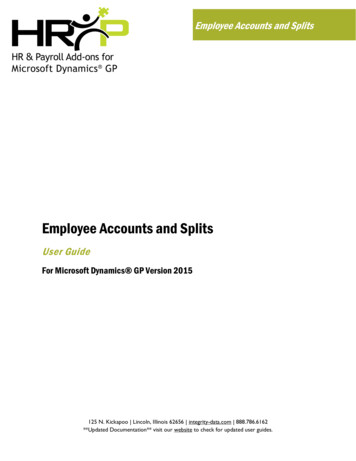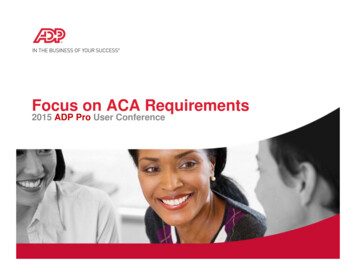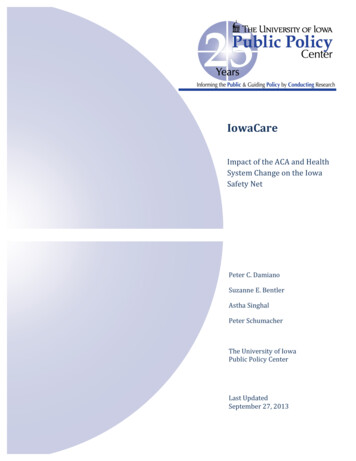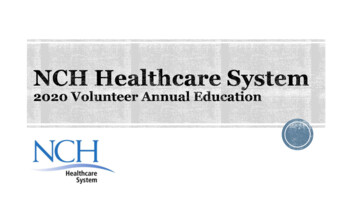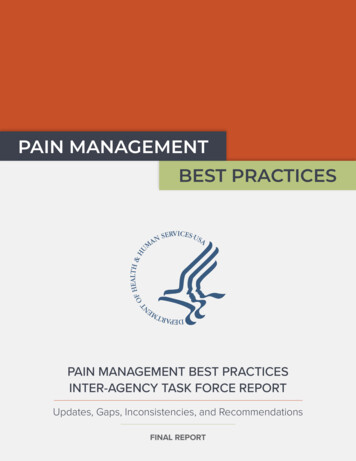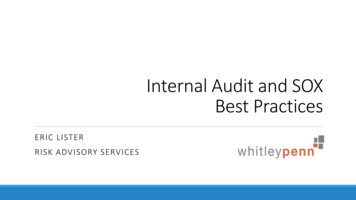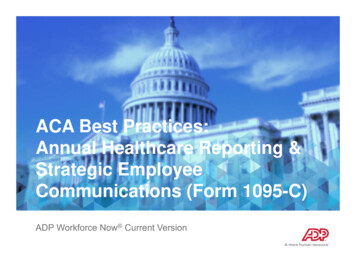
Transcription
ACA Best Practices:Annual Healthcare Reporting &Strategic EmployeeCommunications (Form 1095-C)ADP Workforce Now Current Version
Our SpeakersJohn JankeSr. Director of Program Management, ACAADP, LLCMary SchaferVice President, HCM Strategic CommunicationsADP, LLCJohn is a Certified Healthcare ReformSpecialist and has been an ADP Associatefor more than 30 years. For the past 4years, he has been leading the ACAProgram for ADP Major Accounts andoften speaks on this topic at ADP andindustry events. He is widely regarded asan ACA subject‐matter expert.Mary serves as VP in ADP’s HCM Strategic AdvisoryServices group. As a communications expert, she isresponsible for consulting with clients to providestrategy, advice, insight and practicalcommunications solutions to help drive change.She also leads ADP’s HCM StrategicCommunications group, a team that developscommunications for clients. Mary brings 19 years ofdynamic, innovative and well‐rounded marketingleadership with documented success incommunications, marketing, public relations,branding, events, and employee programs.3 Copyright 2015 ADP, LLC. Proprietary Information.
DisclaimerThis presentation is not: Legal Advice The Final Word on Health Care Reform A Political OpinionADP DOES NOT PRACTICE LAW OR GIVE LEGAL ADVICEADP STRONGLY RECOMMENDS THAT CLIENTS OBTAIN QUALIFIED LEGAL COUNSELPRIOR TO MAKING ANY DECISIONS4
Polling Question #1How prepared is your company/organization to effectivelymanage the complexity of Annual Reporting? Not at all Slightly Moderately Very Extremely55 Copyright 2015 ADP, LLC. Proprietary Information.
Webinar ProgramIn this webinar, we will review several topics: Understanding the Annual Reporting Requirements Workforce Now Sources of Data for Forms 1095‐C and 1094‐C Explanation and Examples of Form 1095‐C: Employer‐Provided HealthInsurance Offer and Coverage Explanation and Examples of Form 1094‐C: Transmittal of Employer‐ProvidedHealth Insurance Offer and Coverage Information Returns6
While Annual Health Care Reports Are “W-2 like”They Are Not SimpleDataSource Annual reporting requirementsrequire data to be captured,tracked, and reported fromsystems of record in new ways As a point of comparison to Form W-2;1094‐CEmployer#* ofElements1095‐CEmployee#* tion133Other4**22830FederalW‐22020– W-2 fields come from 1 system of record vs. up to 5 for annual IRS informationreporting– W-2 has field data mapping vs. derivation or calculation of data for fields to populatefrom systems of record to IRS reports7 Copyright 2015 ADP, LLC. Proprietary Information.
Data Elements Needed Data will come from these major sources:‐HR‐PayrollTime and Attendance*‐Benefits A wide range of data elements will be required in order to document,comply, and do required reportingHRTime andAttendance Indicative dataDate of hireDate of most recent terminationMost recent date of hireDependent Date of BirthACA FT Status effective dateUnion statusState of residence Jury DutyFMLAUSERRAScheduling Messages8Payroll Hours worked and paidHours not worked but paidPayroll period begin / end dateHourly rate of payRate of pay effective dateBox‐1 W‐2 ValueSSNBenefits MEC documentation60% Minimum Value DocumentationProof of offeringEE cost by planStatus indicator (i.e, enrolled, waived)Plan funding (i.e., insured / self‐insured
g1Shared Responsibility (Employer Mandate): DecisionFlow To Avoid Penalties1stCHECKEmployer has, on average, 100 in 2015 (50in 2016) ACA full‐time employees plus full‐time equivalent employees in the prioryear?YES2ndCHECKDoes the employer offer minimumessential coverage (MEC) to at least 70%in 2015 (95% in 2016) of its ACA full‐timeemployees?YES3rdCHECKDoes the plan provide coverage of at least60% minimum value?IRC §4980H(a) – “The Big Penalty”NO4CHECKYESThe penalty (assessedmonthly, per EIN) for notoffering coverage is thenumber of full-timeemployees (minus 80 in2015; 30 in 2016)times 2,080 annuallyNOThose employees canchoose to buy coverage in aMarketplace/Exchange andmay receive a premium taxcreditWould any full‐time employees pay morethan 9.5% of current year for lowest costself only coverage Box 1 W‐2 Wages, Rate of pay, or Federal Poverty LevelDid at least one employeereceive a premium tax creditor cost-sharing subsidy in aMarketplace/Exchange?IRC §4980H(b) – “The Lesser Penalty”YESthPenalties do not apply tosmall employers.NOYESNONo Penalty Payment Required9The penalty (assessedmonthly, per EIN) for failureto offer minimum valueand/or affordable coverageis a 3,000 annual penaltythat will be due for each fulltime employee receiving asubsidy, up to a maximumof the total number of fulltime employees (minus 80in 2015; 30 in 2016) times 2,000
Slide 9g1In the first Check - it is not 50 full-time "plus" 50 Full-time equivalents - it is 50 full-time employees INCLUDING full-time equivalentemployees.greenji, 9/16/2015
What do employers need to know about AffordableCare Act reporting?Under the Affordable Care Act (ACA), Applicable Large Employers (ALEs) arerequired to take some new actions. These employers must file information returns with the IRS and also providestatements to full‐time employees about health coverage the employer offered orto show the employer didn’t offer coverage. Information reporting was voluntary for calendar year 2014. All applicable largeemployers are required to report health coverage information for the first time inearly 2016 for calendar year 2015.10
What is an Applicable Large Employer?An Applicable Large Employer (ALE) is an employer with 50 or more full‐timeemployees – including full‐time equivalent (FTE) employees A full‐time employee is defined by ACA as working 30 hours per week and/or 130hours per month ALE’s with 50‐99 full‐time employees (including FTE employees) will not be penalizedfor non‐compliance with Employer Shared Responsibility requirements in 2015, but arerequired to provide 1095‐C forms to full‐time employees and file a copy with the IRS ALE’s with 100 or more full‐time employees (including FTE employees) are also subjectto other the Employer Shared Responsibility requirements in 2015, and can bepenalized for non‐compliance11
How can Workforce Now help figure out ApplicableLarge Employer status? For 2015, an employer must use a minimum of 6 consecutive months of 2014 payrolldata, based on hours of service in order to determine ALE status For 2016 and beyond, the employer must use payroll data for the entire prior calendar year The ALE Worksheet in Workforce Now guides employers in determining ALE statusReports Standard Reports Personal & Employment ACA Applicable Large EmployerWorksheet12
g2Workforce Now ALE Worksheet13
Slide 13g2Note that there is a new rule where clients can exclude any veterans from this number if the veteran receives govt health insuarncelike TRICARE or VA coverage. Just in case it comes up. Law was just signed in July.greenji, 9/16/2015
How Clients information is delivered to IRS & ClientEssentialACAHealth ComplianceDashboardBenefit Offering ScreenWFN DataDrivenStep 1Step 2Print 1095‐Cforms &PackageIRS 1094‐C &1095‐CElectronicallyfiledStep 3141095‐C/ 1094‐CPackageDelivered toClient
g3Is Form 1095-C filed for every employee and do allemployees receive a copy? An ALE member must file Form 1095‐C for each employee who was afull‐time employee of the ALE for any month of the calendar year A full‐time employee is defined by ACA as working 30 hours per weekand/or 130 hours per month An ALE member also must furnish a completed Form 1095‐C to eachfull‐time employee This form must be furnished regardless of whether the ALE memberoffers coverage, or the employee enrolls in any coverage offered Self‐insured ALE’s must also provide a Form 1095‐C to all part‐timeemployees, and non‐employees, who enrolled in self‐insured healthcoverage provided by the ALE during any calendar month in 201515
Slide 15g3ADP is not supporting any of the alternative reporting method - including these substitute forms.greenji, 9/16/2015
How can Workforce Now help determineFull-Time Employee Status?There are several tools in Workforce Now: Measurement Periods to establish employee statusACA Look‐Back Worksheet to review ACA full‐time or part‐time statuson a month‐by‐month basisNew Employees: Employees “reasonably expected” to work 30 hours or more per week, or 130 hours or moreper month, need to be offered coverage within the first 3 months of employmentEmployees not “reasonably expected” to work 30 hours or more per week, or 130 hours ormore per month, can be included in Initial Measurement Periods (IMP) to determine full‐timeor part‐time statusOngoing Employees: Employees need to be included in Standard Measurement Periods (SMP) to determine full‐time or part‐time status16
How can Workforce Now help track dataon ACA Benefit Status?ACA Dashboard: Process Benefits ACA Measurement Periods17
How can Workforce Now provide visibility ofACA Benefit Status?ACA Benefit Status: People Benefits ACA Benefit Status18
How can Workforce Now help determine Full-TimeEmployee Status?ACA Look‐Back Worksheet: Reports Custom Reports Sample Reports19
Form 1095-C: Employer-Provided Health InsuranceOffer and Coverage20
What information must be provided on Form 1095-C?Part I – General Information Lines 1‐6: Employee Data Name, SSN, and Address Lines 7‐13: Applicable Large Employer Member Data Employer Name, Federal Employer Identification Number (FEIN),Address, and Contact Phone NumberPart II – Employee Offer and Coverage Line 14: Offer of coverage code must be entered for each month of 2015 Line 15: Employee share of lowest cost monthly premium for self‐only,minimum value coverage (must include any cents) Line 16: Applicable Section 4980H Safe Harbor (must follow hierarchyrules if multiple codes apply; leave blank if none apply)21
Form 1095-C Part II Line 14: Offer of CoverageExample 1January‐November Code 1C: Employer offered Minimum Value (MV), Minimum Essential Coverage (MEC) tothe employee and dependents but NOT spouseDecember Code 1H: Employee terminated in November, therefore no offer of coverage in DecemberExample 2January‐June: Code 1B: Employer offered Minimum Value (MV), Minimum Essential Coverage (MEC) toemployee only for a non calendar year plan beginning July 2014July‐December: Code 1D: Employer offered Minimum Value (MV), Minimum Essential Coverage (MEC) tothe employee and MEC to spouse in new plan year beginning in July 201522
How can Workforce Now help employers complete Line14 of Form 1095-C?Setup Benefits Plan Setup: Plan Class DetailsWhen you set up your benefit plans, youhave the ability to attest that the plansqualify as:1) providing Minimum Essential Coverage2) providing Minimum Value Coverage23
How are the 1095-C codes on Line 14 determined?Part II – Employee Offer and Coverage Line 14: Offer of coverage code must be entered for each month of 2015Benefit Offering ScreenHealth ComplianceDashboard24
Form 1095-C Part II Line 15: Employee Share of LowestCost Monthly Premium for Self-Only Minimum ValueCoverageEnter the lowest‐cost monthly premium for self‐only minimum essentialcoverage providing minimum value that is offered to the employee This amount may not be the amount the employee is paying for the coverage; forexample, if the employee chose to enroll in more expensive coverage, such asfamily coverageJanuary‐June: Lowest cost of self‐only coverage offered to the employee was 200July‐November: Lowest cost of self‐only coverage offered to the employee was 90December: Blank. Employee was terminated in November and was not a full‐time employee forany day in December25
How can Workforce Now help employers complete Line15 of Form 1095-C?Setup Benefits Plan Setup: Coverage Levels Indication of monthly premium for self‐only coverage26
Form 1095-C Part II Line 16: Applicable Section4980H Safe HarborLine 16 includes information needed to determine whether the employer may be liable for ashared responsibility payment Codes are entered to identify employees who were not employed or who were not full‐time duringa month, or who enrolled in coverage offeredJanuary‐May Code 2F: Form W‐2 affordability safe harborJune‐November Code 2C: Employee enrolled in coverage offered Note that Code 2C trumps all other codes on Line 16December Code 2A: Employee was not employed on any day of the month27
Form 1095-C Part III Covered Individuals Part III of Form 1095‐C should be completed only if the ALE has a self‐insured grouphealth plan If ALE is fully‐insured, Part III is not completed, and Form 1095‐B is provided by the healthinsurance issuer List the SSNs for the covered Employee and any covered family members, and indicatethe months of coverage January‐August Employee and dependent were not enrolled in coverage September‐December Employee and dependent were enrolled in coverage offered by the Employer28
How can Workforce Now help employers complete PartIII of Form 1095-C?Setup Benefits Plan Setup Settings: Indication of Self‐Funded Plan29
Form 1094-C: Transmittal of Employer-Provided HealthInsurance Offer and Coverage Information Returns30
Will all employers need to complete Form 1094-C? An ALE is required to file a Form 1094‐C even if the ALE does not offerhealth coverage to its employees Separate reporting of 1094‐C must be submitted for each Federal EmployerIdentification Number (FEIN) associated with an ALE Separate reporting by FEIN is required even if several related ALEs usingdifferent FEINs are covered under the same health plan If an Aggregated ALE Group includes multiple FEINs, each FEIN for eachmember of the group must be listed in Part IVNote: An Aggregated ALE Group refers to a group of ALE Members treated as a single employerunder section 414(b),(c), (m) or (o) of the Internal Revenue Code.ADP recommends that employers consult with outside counselto determine if they are members of an Aggregated Group of ALEs.31
g5g6Form 1094-C Part I and Part IIPart I: Applicable Large EmployerMember (ALE Member) Lines 1‐8: ALE Member Data Lines 9‐16: Designated GovernmentEntity (DGE) Information Line 17: Reserved for IRS Line 18: Total Forms 1095‐C submittedPart II: ALE Member Information Line 19: Authoritative Transmittal Line 20: Total Forms 1095‐C filed Line 21: Aggregated ALE Group Line 22: Certifications of Eligibility32
Slide 32g5John - It's not really that an employer should consult with outside counsel to determine if they are part of a DGE. It is more that if theDGE is going to file on behalf of another FEIN, then the IRS wants to know that. So, let's say a state runs the plan and is going toreport for the municipalities that participate in the plan. The State would be the DGE and should fill out this information, but theemployer they are reporting on should go in the top. so, they should know if they are a DGE filing for other entities or not. You maynot want to say anything.greenji, 9/16/2015g6You know that ADP HC is only filing one authoritative transmittal, right. The idea is that you don't have to fill out all of Form 1094-Cunless it is the authoritative transmittal.greenji, 9/16/2015
How can Workforce Now with Essential ACA helpwith Form 1094-C Part II?Resources Company Information Company Profile ACA Aggregated ALE GroupLine 21: Is ALE Member a member of an Aggregated ALE Group? Checked if FEIN for which reporting is being submitted is part of an Aggregated ALE Group thatincludes multiple FEINs. If checked, Part IV of Form 1094‐C must be completed.33
Form 1094-C Part III ALE Member Information – MonthlyALE Member Information ‐ Monthly Column a: Minimum Essential Coverage (MEC) Offer Indicator (Yes/No)Column b: Full‐Time Employee Count for ALE MemberColumn c: Total Employee Count for ALE MemberColumn d: Aggregated Group Indicator If information in the columns is the same throughout 2015, the “All 12 Months”option can be used; otherwise, information must be provided for each month Column e: Section 4980H Transition Relief Indicator A is used for an ALE with 50‐99 full‐time and/or full‐time equivalent employees B is used for an ALE with 100 or more full‐time and /or full‐time equivalent employees34
Form 1094-C Part IV Other ALE Members of AggregatedALE GroupPart IV of 1094‐C must be completed if Box 21 in Part II is checked to indicatethat the ALE is a member of an Aggregated ALE Group Name and FEIN for each member of the ALE Group must be provided Members are listed from those with the most employees to those with the fewestemployees35
What are the deadlines for the annual reporting?Form 1095‐C: By February 1, 2016 must be distributed to eachemployee who was full‐time for any month of 2015 Self‐insured employers must also provide Form1095‐C to non full‐time employees who enrolled inself‐insured coverage offered by the employerForm 1094‐C: Must be filed with the IRS when an employer filesone or more Forms 1095‐CFiling Deadlines for 1095‐C and 1094‐C: February 29, 2016 if filing paper forms March 31, 2016 if filing electronically Electronic filing is required if filing 250 or moreforms36
Q&A37
Your ADP Health Compliance SolutionExchangesEligibilityAffordabilityReporting and AnalyticsBenefitsAnnual HealthCare Statements AnnualReporting‒ 1094-C ERTransmittal‒ 1095-C EEStatementsHR‒ Preview formsPayrollTime & LeavesHuman Capital Management Platforms38IRS
Polling Question #2Will your company be managing Form 1095-C and 1094-Crequirements using: Internal resources only Outsourcing this process A combination of both internal and outsourced resources Not sure at this time3939 Copyright 2015 ADP, LLC. Proprietary Information.
40
How do employers determine if their organizationis considered an Applicable Large Employer?STEP1Determine the number of full‐time employees – including full‐time equivalent(FTE) employees – using the Applicable Large Employer (ALE) Worksheet inWorkforce Now, based on at least 6 months of 2014 payroll data. 100 or more employees 50 to 99 employees Less than 50 employeesMinimum EssentialCoverage (MEC) must beoffered to 70% of full‐timeemployees during 2015,and Forms 1094‐C and1095‐C are requiredNo penalties for non‐compliance with EmployerShared Responsibilityduring 2015, but Forms1094‐C and 1095‐C are stillrequiredNot subject to EmployerShared Responsibilityrequirements, includingreporting41
How does an employer identify its full-timeemployees?STEP2Determine full‐time employee status, according to the ACA, by setting upMeasurement Periods using the Workforce Now Benefits module, and/orprocessing the ACA Look‐Back Worksheet in Workforce Now New EmployeesEmployees “reasonablyexpected” to work 30hours or more per week,or 130 hours or more permonth, need to beoffered coverage withinthe first 3 months ofemployment Ongoing EmployeesEmployees not“reasonably expected” towork 30 hours or moreper week, or 130 hoursor more per month, canbe included in InitialMeasurement Periods(IMP) to determine full‐time or part‐time status42Employees should beincluded in StandardMeasurement Periods(SMP) to determine full‐time or part‐time status
How does an employer determine lowest cost minimumvalue coverage?STEP3Use the Workforce Now Benefits module for the following: Set up benefit plans and plan classes for employee self‐only coverage options After appropriate verification, certify that benefit plans and plan classesprovide Minimum Value coverage Determine all benefit plans and plan classes in which the employee is eligibleto enroll Verify the cost to the employee of each coverage option43
Are there different requirements for fully-insuredemployers and self-insured employers?STEP4 Fully‐Insured Self‐Insured Only parts
Sep 16, 2015 · Sr. Director of Program Management, ACA ADP, LLC John is a Certified Healthcare Reform Specialist and has been an ADP Associate for more than 30 years. For the past 4 years, he
